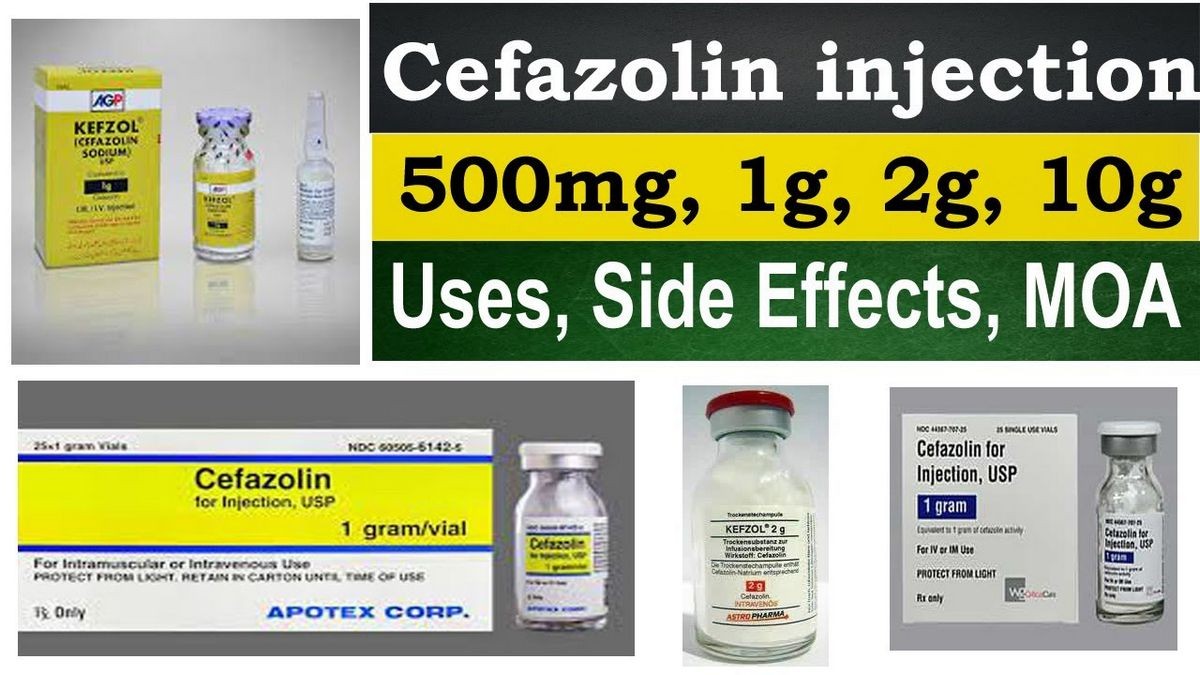
Contents
cefazolin
Cefazolin is a broad spectrum antibiotic used to treat bacterial infections. It is active against many gram-positive and gram-negative bacteria. However, it is a first generation cephalosporin and many strains have developed resistance to it. Gram-negative bacteria have an additional membrane outside the cell wall that gram-positive bacteria lack.
Cefazolin kills bacteria by inhibiting the synthesis of peptidoglycan, a vital component that provides stability to the bacterial cell wall. Cephalosporins are beta-lactam antibiotics that contain a beta-lactam ring in their chemical structure. Bacteria develop resistance to beta-lactam antibiotics by producing beta-lactamases, enzymes that cleave the beta-lactam rings in the antibiotics and destroy them. Organisms susceptible to cefazolin include:
- Gram-positive bacteria:Staphylococcus aureus (methicillin-susceptible strains, including those producing penicillinases), Staphylococcus epidermidis, Group A beta-hemolytic streptococci and other strains of streptococci (many strains of enterococci are resistant), Streptococcus pneumoniae
- Gram-negative bacteria:Escherichia coli, Klebsiella species, Proteus mirabilis, Haemophilus influenzae, Enterobacter aerogenes
Cefazolin is used to treat respiratory tract, urinary tract, skin and skin structure, biliary tract, bone and joint, genital, septicemia, and endocarditis infections. It is also used for perioperative prophylaxis. Off-label uses include bacterial keratitis, peritonitis treatment in peritoneal dialysis patients, Streptococcus (group B) maternal prophylaxis for prevention of neonatal disease, and toxic shock syndrome.
Warnings
- Do not administer cefazolin to patients with known hypersensitivity to cephalosporin group of antibiotics
- Use cefazolin with caution in patients with a history of penicillin allergy because cross-hypersensitivity among penicillin and beta-lactam antibiotics may occur
- Endocarditis prophylaxis recommended only for high-risk patients, per American Heart Association (AHA) guidelines
- Use of nearly all antibacterial agents including cefazolin can lead to Clostridium difficile overgrowth and associated diarrhea or colitis
- Prolonged or repeated use may result in bacterial and fungal overgrowth of non-susceptible organisms
- Use of cefazolin injection in the absence of proven or strongly suspected bacterial infection or a prophylactic indication is unlikely to provide benefit to the patient and increases the risk of development of drug-resistant bacteria
- Use with caution in patients with seizure disorders; high doses are associated with increased risk of seizures
- Cefazolin may increase blood clotting time, particularly in patients with impaired kidney or liver function, poor nutritional state, patients on prolonged antimicrobial therapy and patients previously stabilized on anticoagulant therapy
What are the side effects of cefazolin?
Common side effects of cefazolin include:
- Injection site reactions such as tissue hardening (induration), inflammation of vein (phlebitis), and pain
- Skin rash, hives (urticaria), and itching (pruritus)
- Stevens-Johnson syndrome and acute generalized exanthematous pustulosis
- Low leukocyte count (leukopenia), low neutrophil count (neutropenia), low platelet levels (thrombocytopenia), elevated platelet levels (thrombocythemia), and elevated eosinophil levels (eosinophilia)
This is not a complete list of all side effects or adverse reactions that may occur from the use of this drug.
Call your doctor for medical advice about serious side effects or adverse reactions. You may also report side effects or health problems to the FDA at 1-800-FDA-1088.
What are the dosages of cefazolin?
Powder for Injection
Adult:
Moderate-to-Severe Infections
- 0.5-1 g intravenous (IV) every 6-8 hours
Mild Infections with Gram-Positive Cocci
- 250-500 mg IV every 8 hours
Mild-to-Moderate Cholecystitis
- 1-2 g IV every 8 hours for 4-7 days
- 1 g IV every 12 hours
Preparation for Surgery
Prophylaxis against infection
- Preoperatively: 1-2 g intravenous/intramuscular (IV/IM) within 1 hour before procedure (may be repeated in 2-5 hours intraoperatively)
- Postoperatively: 0.5-1 g IV every 6-8 hours for 24 hours
- Cardiac procedures, hysterectomy, oral or pharyngeal procedures, craniotomy, joint replacement, thoracic procedures, arterial procedures, amputation, traumatic wounds; high-risk esophageal, gastroduodenal, or biliary tract procedures: 1-2 g IV
- Colorectal procedures: 1-2 g IV plus metronidazole 0.5 g IV
- High-risk cesarean section, 2nd trimester abortion: 1 g IV
- Ophthalmic procedures: 100 mg subconjunctivally
- 1 g IV/IM 30-60 minutes before procedure
- American Heart Association (AHA) guidelines: Endocarditis prophylaxis recommended only for high-risk patients
Bacterial Keratitis (Off-label)
- 1 drop instilled into affected eye(s) every 1-2 hours; typically alternated with antibiotic providing gram-negative coverage (e.g., tobramycin)
- Extemporaneous compounded fortified cefazolin 50 mg/mL
- Dilute 500 mg parenteral cefazolin powder in sterile water to form 10 mL solution
- Store refrigerated; preparation expires in 7 days
Dosing Modifications
- CrCl 35-54 mL/min: Give full dose at intervals longer than 8 hours
- CrCl 10-35 mL/min: Give therapeutic dose every 12 hours
- CrCl 10 mL/min or less: Give therapeutic dose every 24 hours
Pediatric:
Infections with Gram-Positive Cocci
Neonates (younger than 28 days)
- Younger than 7 days: 40 mg/kg/day IV/IM divided every 12 hours
- Older than 7 days, weight less than 2 kg: 40 mg/kg/day IV/IM divided every 12 hours
- Older than 7 days, weight greater than 2 kg: 60 mg/kg/day IV/IM divided every 8 hours
- 25-100 mg/kg/day IV/IM divided every 6-8 hours; not to exceed 6 g/day
- 50 mg/kg IV/IM 30-60 minutes before procedure; not to exceed 1 g
- AHA guidelines: Endocarditis prophylaxis recommended only for high-risk patients
Community-Acquired Pneumonia
- Children 3 months and older: 150 mg/kg/day IV/IM divided every 8 hours (moderate to severe infections, methicillin susceptible S. aureus preferred
Dosing Considerations
- Cefazolin 2 g for Injection USP and Dextrose Injection USP are not recommended for use in pediatric patients; to avoid unintentional overdose, 1 g cefazolin for Injection USP and dextrose Injection USP should only be used in pediatric patients who require entire contents of 1 g dose and not any fraction of it
- There are no dosing recommendations for pediatric patients for perioperative prophylaxis or for pediatric patients with renal impairment
What drugs interact with cefazolin?
Inform your doctor of all medications you are currently taking, who can advise you on any possible drug interactions. Never begin taking, suddenly discontinue, or change the dosage of any medication without your doctor’s recommendation.
- Cefazolin has no known severe interactions with other drugs.
- Serious interactions of cefazolin include: antithrombin alfa, antithrombin III, argatroban, BCG vaccine live, bivalirudin, cholera vaccine, dalteparin, enoxaparin, fondaparinux, heparin, and typhoid vaccine live
- Bazedoxifene/conjugated estrogens, dienogest/estradiol valerate, estradiol, and ethinylestradiol interact with cefazolin
- Levonorgestrel oral/ethinylestradiol/ferrous bisglycinate, probenecid, sodium picosulfate/magnesium oxide/anhydrous citric acid, voclosporin, and warfarin interact with cefazolin
- Aspirin/citric acid/sodium bicarbonate, biotin, chloramphenicol, furosemide, ketorolac intranasal, pyridoxine (Antidote), rose hips, sulfasalazine, and willow bark interact with cefazolin
The drug interactions listed above are not all of the possible interactions or adverse effects.
It is important to always tell your doctor, pharmacist, or health care provider of all prescription and over-the-counter medications you use, as well as the dosage for each, and keep a list of the information.
Check with your doctor or health care provider if you have any questions about the medication.
Pregnancy and breastfeeding
- Available data do not show any evidence of fetal harm with the use of cefazolin during pregnancy and is acceptable for use in pregnant women.
- Cefazolin is one of the recommended antibiotics that may be used prior to vaginal delivery in patients at high risk for endocarditis. Cefazolin may also be used prior to Cesarean deliveries.
- Cefazolin is present in very low concentrations in the milk of nursing mothers; use with caution.
By clicking Submit, I agree to the MedicineNet’s Terms & Conditions & Privacy Policy and understand that I may opt out of MedicineNet’s subscriptions at any time.
Summary
Cefazolin is a broad spectrum antibiotic used to treat bacterial infections, including respiratory tract, urinary tract, skin and skin structure, biliary tract, bone and joint, genital, septicemia, and endocarditis infections. Common side effects of cefazolin include injection site reactions, low blood pressure (hypotension), fainting (syncope), abdominal cramps and pain, loss of appetite (anorexia), diarrhea, gas (flatulence), heartburn, oral candida yeast infection (candidiasis), and others.


